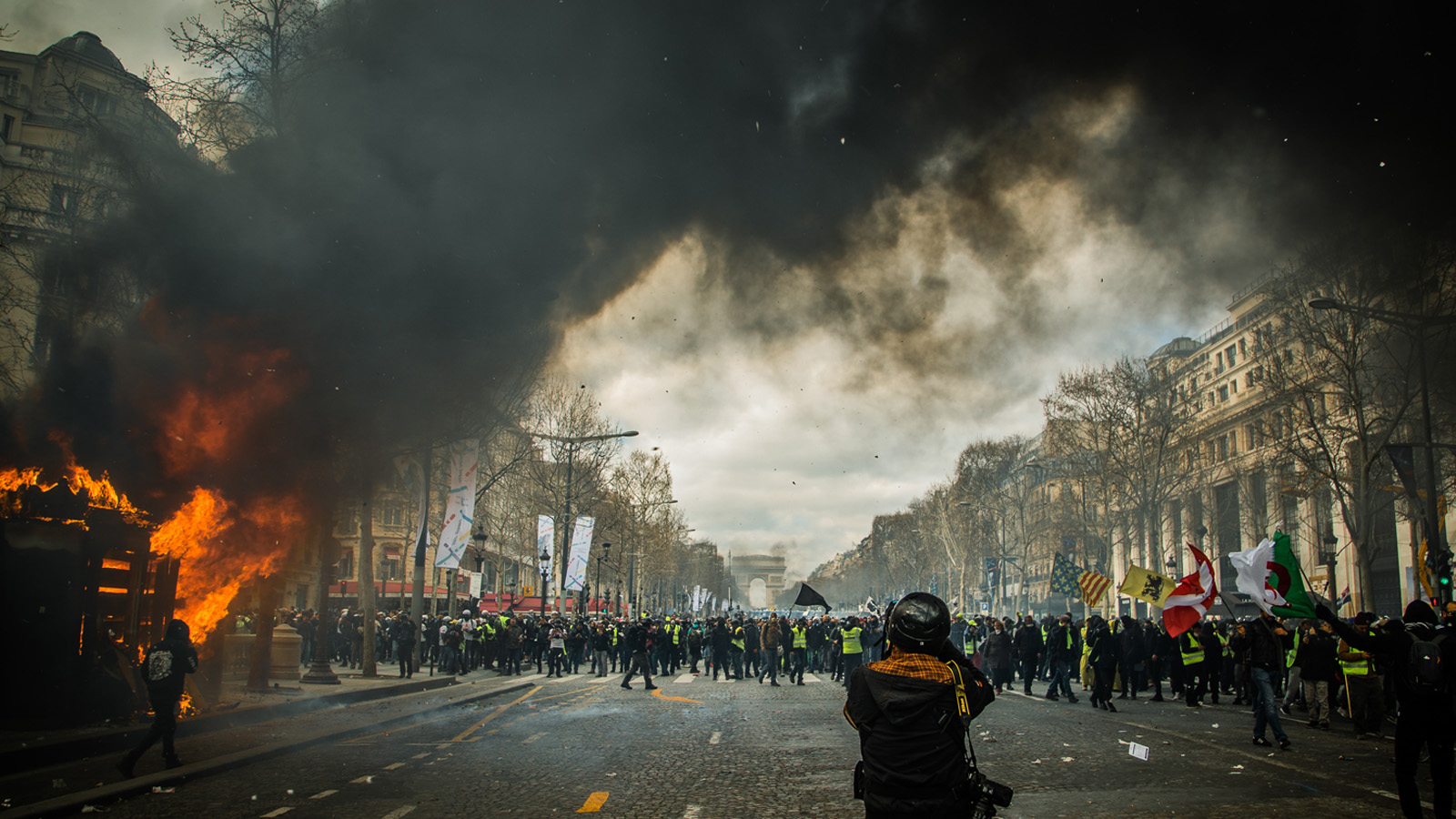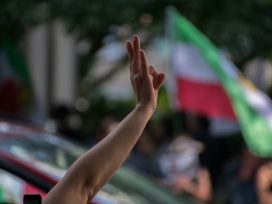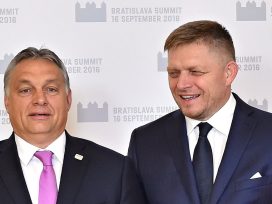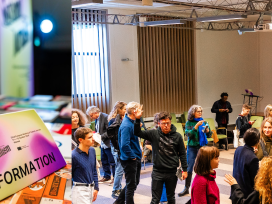Like many people, the first I saw of the gilets jaunes was on the television. On Saturday 17 November 2018, sitting in a kebab shop with a friend in central Paris, we watched the images of yellow-vested protestors streaming through the streets of the capital, blocking up the périphérique ring road, and slowing traffic on rural roundabouts across the country. The headline on the 24-hour news channel read ‘Gilets jaunes protest against the rise in fuel tax’. I was impressed – and more than a little suspicious. Who were these protestors?
It certainly looked like a popular uprising. And yet my genteel political sensibilities bristled at the anti-tax impetus – surely this was a revolt from, or for, the right. Whatever it was, it looked big. The following Saturday I went to see the protests on the Champs Élysées, the most famous shopping street in Paris, which was gearing up for the Christmas season. By the time I arrived the fires were already lit. The habitual rhythm of shopping had been interrupted as yellow-vested demonstrators wandered up and down the boulevard and lingered next to burning wheelie bins. And not a police officer in sight.
In the intervening week I had heard differing accounts of who exactly the gilets jaunes were. Naively eager for an answer, I approached three men in their thirties and asked them why they were there. Their response could not have been more incisive: ‘And you? Why are you here?’ My role of innocent observer was cut to shreds. A quick explanation sufficed: they were sick of getting up in the morning and going to work just to scrape by at the end of each month; sick of paying taxes; sick of the lives they felt stuck with. Their rage and suffering was palpable. And if I didn’t understand these sentiments – instinctively and immediately – there was only one possible reason: I clearly wasn’t in the same boat.
In many ways, my initial reaction to the gilets jaunes – from vague suspicion to a slow grasp of the sufferings driving the movement – mirrors that of the bulk of the French left. Indeed, such was the blindness of political classes and autonomous activists alike who thought that the movement appeared to come ‘out of nowhere’. In reality, the momentum had been building for months.
On the 29 May 2018, Priscillia Ludosky, a 33-year-old entrepreneur of Martiniquan descent, had published an online petition calling principally for the lowering of the price of fuel. As her petition quietly crept into the tens and then hundreds of thousands, and a Facebook event was launched for country-wide protests, the government remained silent. Then, on 14 November, the prime minister Édouard Philippe announced that the government would not be budging on the scheduled fuel tax increases – labelled a ‘carbon tax’ and justified as part of a largely absent ‘ecological transition’ – and instead proffering tax breaks on the purchase of less polluting vehicles. It was very much too little too late.
Organised entirely online, principally via Facebook groups and events, and without the support of France’s combative trade unions and sizeable extra-parliamentary left, the first day of protests saw an estimated 287,000 people participate in over 2000 road blocks and gatherings across the country.
The idea of using fluorescent yellow safety vests as the symbol of the movement emerged on Facebook too. On 24 October, Ghislain Coutard posted a video of himself in his car: ‘We’ve all got a yellow vest in the car [required by law in France]. Chuck it on the dashboard so people can see it … a little colour code to show that you agree with us, with the movement’. The video went viral and by the 17 November the movement had been officially baptised as the ‘gilets jaunes’ by the media. Since then, the potency of this symbol has been much commented upon.
Certainly, the yellow vest is most clearly associated with driving in France, therefore evoking the ‘motorist’ identity that first characterised the movement. Yet the yellow vest has other more free-floating significations. Most obviously, it is a matter of visibility: the yellow vest as a means of bringing suffering and injustice out of the private sphere and into the light of day. Then there is the relative political autonomy of the colour yellow in France, which is not used by any of the major parties. And finally, as an object it is both ordinary and urgent – it is widely available and ‘of the people’ and yet it simultaneously signals crisis and emergency. So it was that the yellow vest became an instant offline meme.
Despite the huge turnout on the first day of protests, the trade unions kept their distance. Given the movement’s anti-tax starting point and the rumours circulating about the participation of fascists and far right activists, it is not hard to understand why. And the far right were indeed quick to jump on the bandwagon, and various well-known fascists, royalists and ultra-nationalists – such as Hervé Ryssen, Yvan Benedetti and Victor Lenta – were spotted on demonstrations. The first high profile party politicians attempting to capitalise on the populist potential of the movement were Marine Le Pen (leader of Rassemblement National (RN), formerly the Front National) and Nicolas Dupont-Aignan (leader of Debout La France, a smaller rival of the RN). Even Laurent Wauquiez (of the centre-right Republicans) attempted to ride the wave to promote his neoliberal low-tax agenda.
From the left, Jean-Luc Mélenchon soon joined the chorus, calling on members of his party La France Insoumise to join the movement. Outside party ranks, the autonomous left likewise soon began participating in the demonstrations. Amongst the trade unions, old rifts opened up between base and leadership as to how to relate to the movement (debates are ongoing at the time of writing). In short, things got complicated quickly.
And yet despite the bazaar of opposing currents constituting – and leeching off – the gilets jaunes, a certain coherency took shape. Though the terrain at first seemed fertile for the right, the movement appeared to move left. Starting out in opposition to increasing fuel taxes, their demands quickly radicalised. Although a neat, linear direction of travel would be impossible to identify, the broad progression of the movement – propelled by the government’s line, severe police repression and internal conflicts – appeared to shift from anti-tax politics to a demand for tax justice, to a demand for justice tout court, to anti-systemic demand for direct democracy. This progression, which can be traced roughly across the lifespan of the movement, was to a large extent enabled by one, unifying demand: the deposition of the president.
And, certainly, Emmanuel Macron’s pivotal role in the gilets jaunes movement warrants sustained reflection. As highlighted by Didier Fasson and Anne-Claire Defossez, his profoundly condescending approach to neoliberal reform was a significant factor in catalysing the revolt. After his victory in the presidential election of 2017, there was an abrupt transformation in Macron’s image. Gone were the chummy interviews with journalists and the down-to-earth friendliness of the campaign trail – from his inauguration onwards, Macron’s presidency has been marked by a deliberately icy and authoritative posture. This new image was what Macron himself described as the ‘Jupiter’ model, drawing on the mythology of the Roman sky god: all-powerful, aloof, removed from the daily cut-and-thrust of politics. The aim, according to the president himself, was none other than to found ‘a new form of democratic authority’ based on a ‘universe of symbols’ that could stand in for France’s ‘traumatic’ loss of a monarchic head of state.
This communications strategy was a natural extension of Macron’s political platform: the idea that France’s existing social and political intermediaries (namely trade unions and parties) needed to be bypassed or bulldozed in order to ram through a programme of long stunted neoliberal reform. And this is precisely what Macron had been busy doing in the first eighteen months of his presidency. One of his first acts in office was the replacement of France’s longstanding solidarity tax on wealth (the ISF) with a levy on real estate, the stated intention being to free up capital in order to encourage productive investment in the real economy. Unsurprisingly, this tenet of ‘trickle-down economics’ – along with several ugly slurs directed at the poor – cemented Macron’s image as the ‘president of the rich’. Playing the pragmatism card, he believed that by taking a ‘pedagogical approach’ to policy he could explain his way out of this redistribution of wealth upwards. He was mistaken. The reinstatement of the ISF soon became a rallying cry for the gilets jaunes, shifting the emphasis from the lowering of taxation to the more egalitarian terrain of tax justice.
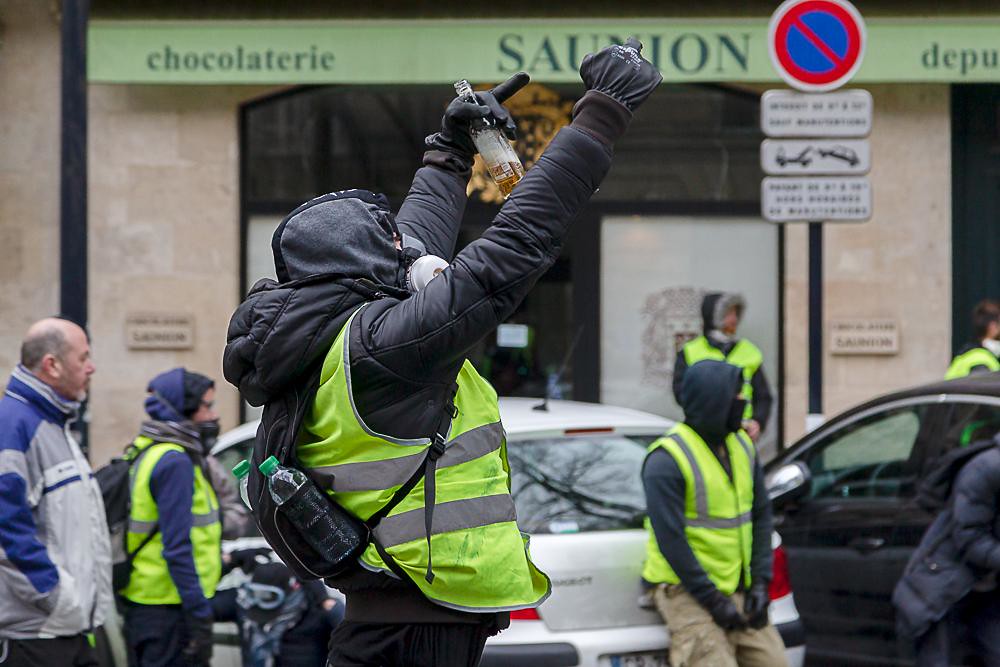
Photo by Patrice Calatayu from Flickr
Citizens’ referendums
Macron’s strategic aloofness has compounded the anti-democratic tendencies that have plagued the Fifth Republic since it was established by Charles De Gaulle in 1958 in an attempt to regain control over France’s revolting colonies. Rather than reforming the immense concentration of presidential power that the Fifth Republic affords, Macron has sought to take full advantage of it, passing laws by ordinance and bypassing parliamentary scrutiny where possible. This is one of the reasons for the emergence of a more radical democratic demand amongst the gilets jaunes: the call for Citizens’ Initiative Referendums (Référendum d’Initiative Citoyenne, RIC), similar to those used in Switzerland and Italy. On 15 December, at an art gallery in central Paris, a group of gilets jaunes read out a text that included a demand for such referendums to be written into the Constitution. Historian Samuel Hayat neatly captured the response:
The media machine then overreacted, letting loose a political agoraphobia – that fear of a people deemed unstable, incapable and dangerous, one of the hatred of democracy’s many avatars. Apparently everyone had forgotten that during the last presidential campaign, no less than six of eleven candidates promised the creation of such a referendum, without that causing scandal. But that’s just it: democratization is acceptable as long as it is granted by professional politicians, yet it is seditious as soon as it becomes a popular demand.
The letters RIC could soon be seen emblazoned in black marker pen across the backs of yellow vests across France as it became the movement’s most prominent demand. Part of its success came from its seemingly cross-cutting nature: if the demand for RIC was won, then all the gilets jaunes’ grievances could be raised and dealt with via referendums. But beyond this silver-bullet thinking, the RIC represents both an expression of a deep distrust of France’s ruling elites and an alternative concept of politics – direct, de-professionalised, and citizen-led.
As Hayat argues, other characteristics of the movement’s politics can be read from their call for the RIC. In part, it reflects the ‘ground zero’ mentality that characterises the yellow vests. This is something that the gilets jaunes could be said to share with a number of other post-financial crisis social movements, from Occupy to Tahir Square and beyond: a highly selective or non-existent historical memory.
Following decades of defeat for the left, such social movements gain a certain dynamism by striking forth without the baggage of tradition. The widespread call for the RIC reveals such thinking on the part of the gilets jaunes, as it rests on a conception of the people as ‘united, with no partisan divisions or ideologies, an addition of free individuals from whom it will be possible to derive a will by a simple mechanism: asking them a question, or by drawing lots to pick a number of these free individuals to deliberate fairly’. But this call for direct democracy, though it offers a radical challenge to ruling elites, also mirrors Macron’s neoliberal conception of politics. While seeking to shift power to the people, it imagines this people as an aggregate of individuals who, much like the neoclassical idea of homo economicus, will make rational decisions on political issues without mediation (and among whom there are no conflicts of interest). No need for ideology, political parties, history, or any analysis of the power relations structuring society.
Indeed, the movement’s focus on the RIC – as well as other aspects of its activism, from its reclaiming of popular sovereignty to its horizontal forms of organising, on- and offline – locate it as a movement that broadly shares many of the characteristics of the ‘movement of the squares’ that is discussed in Paolo Gerbaudo’s wide-ranging study. The gilets jaunes movement broadly takes the form of what Gerbaudo defines as an anarcho-populist ‘citizenism’ – in reference to movements as diverse as Occupy Wall Street, the Indignados in Spain, and the 25 January revolution in Egypt. This sees an indignant, self-organised citizenry pitting itself against economic and political elites and drawing on the symbols of the nation in an attempt to found a ‘true’ democracy. While the gilets jaunes fit broadly into this schema, the particularity of their attachment to one distinct set of historical symbols is worth looking at more closely.
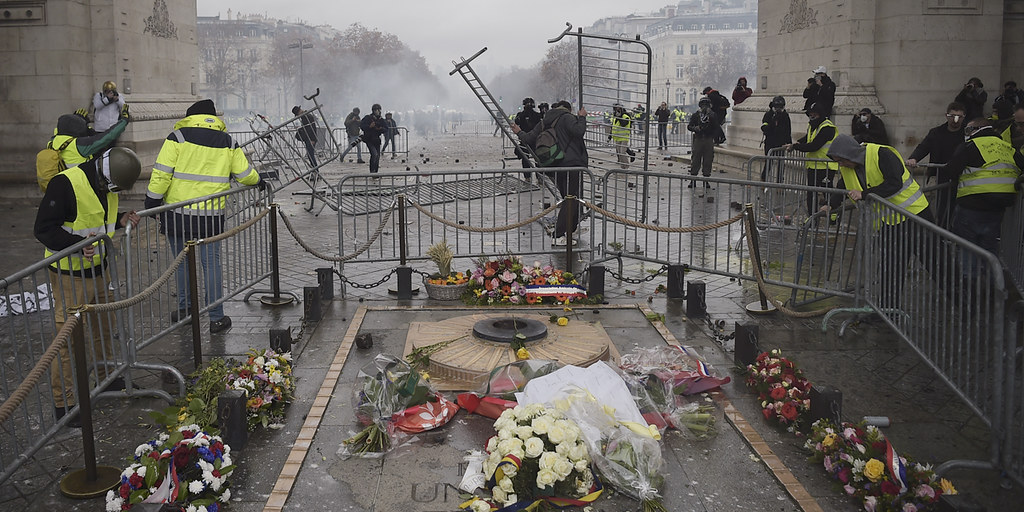
Demonstrators stand next to metal barriers around the tomb of The Unknown Soldier at The Arc of Triomphe during a protest of Gilets jaunes.
Photo by Lucas Barioulet via vfutscher on Flickr
The spectre of the French Revolution
More or less the sole historical reference point for the yellow vests is the French Revolution of 1789. This common denominator has been a symbolic presence on demonstrations from the start: French flags worn as capes or waved on sticks, rousing choruses of La Marseillaise sung by groups of protestors, red Phrygian caps, and even the odd mock guillotine. And the movement’s demands and rhetoric have also been influenced by the French Revolution – as seen in online cahiers de doléances (lists of grievances); demands for the deposition of the president, citizens’ assemblies, direct democracy, an end to fiscal injustice, direct control of representatives and the lowering of their salaries; and calls to form a constituent power. The rest of France’s revolutionary history – the revolution of 1848, the Paris Commune of 1871, the Popular Front of the 1930s, the revolts of May 1968 – is entirely absent. The causes and effects of this highly selective historical memory are numerous and significant.
The revolution of 1789 is of course thoroughly drummed into the collective consciousness (via the school curriculum, the national anthem, the French flag, etc) in a way that other revolutionary episodes are not. While the Paris Commune of 1871 is a symbol for the left, the 1789 revolution’s foundational quasi-universality cuts across the political divide (albeit through hotly contested interpretations). In this sense, it is a populist historic event par excellence, boiled down to the idea of the people versus the elites. According to the editorial committee of the review Temps Critique, it is precisely the imagined universality of the French Revolution that underpins its centrality for the gilets jaunes. They claim that this is a universality under construction, and is being (re)built bit by bit on the occupied roundabouts, through discussion of common hardships, imaginings of a different society, debates with passing motorists, and the construction of cabins and sharing of meals. And they make an optimistic comparison between this nascent universality-from-below and the idea of a ‘republic of Mankind’ proclaimed by Prussian nobleman Anacharsis Cloots during the French Revolution. While this seems a little farfetched, the imagined universality of the people is certainly one of the motors driving the movement. Each gilet jaune feels they are doing this for ‘everyone’ – that they are the legitimate voice of the people. This legitimacy is key: it enables the yellow vests to operate beyond the charge of sectoral specificity and ‘self-interest’ so often used to undermine trade union struggles in France. Or to put it simply, it enables the gilets jaunes to construct themselves as a ‘people’.
The role that the imaginary of the French Revolution plays in the movement can also tell us something about the nature of the ‘people’ in question. In some ways, the gilets jaunes movement is a quintessential example of the ‘populist reason’ theorised by Ernesto Laclau: ‘an aggregation of heterogenous forces and demands which cannot be organically integrated into the existing differential/institutional system’ forms a ‘chain of equivalence’ around the (very) empty signifier of the yellow vest against a common enemy (Macron, the elites, the existing political-economic system, etc). And yet this process is not free-floating discursive play.
Rather, it is embedded within a national discourse that understands contemporary historical conditions through the historical imaginary of the French Revolution. This imaginary is an example of what Alberto Toscano recently described as a ‘“bizarre” historical sedimentation’ of the kind that Gramsci observed – the folklore through which subaltern classes sometimes seek to make sense of the world. The ‘people’ forming behind the empty signifier of the yellow vest is in fact a distorted rehashing of the ‘people’ of the French Revolution. History appears here as ‘folklore’, a story that makes sense of the contrast ‘between the conception of the world and of life of subaltern social strata and that of the “official” (cultured, intellectually dominant) components of society’. Toscano argues that the extent to which these conceptions diverge is indicative of the potential for revolutionary struggle in a given conjuncture. The ‘people’ is thus ‘anything but an empty, political signifier, as a certain post-Marxist current suggests’, and is instead ‘saturated with historical experience’. The contradictory and uneven character of folklore can be seen in the gilets jaunes’ discontinuous and symbolic use of history: the French Revolution is conjured as a series of memes (‘an accretion of historical derivations’) and the rest of France’s revolutionary history is all but forgotten. Finally – and this is key – rather than being ‘tied to the dominant class’, the gilets jaunes’ folkloric use of the French Revolution appears to be ‘in contradiction to or simply different from the morality of the governing strata’. In other words, rather than being nothing more than a fossilised founding myth of the nation, the French Revolution is mobilised as a weapon against the contemporary political system, as a statement of radical democratic intent.
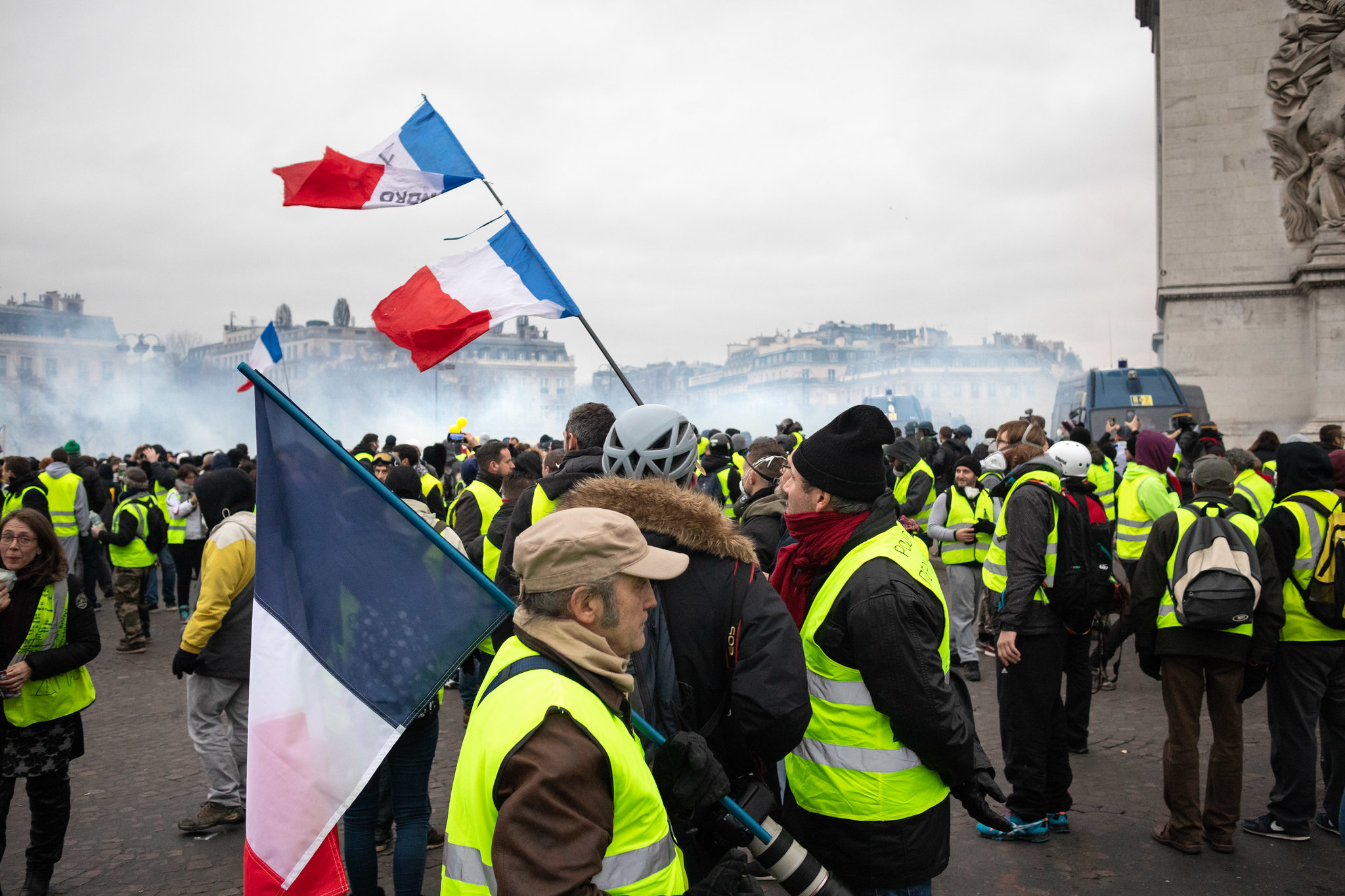
Gilets jaunes in Place de l’Etoile on 12/01/2019
Photo by Olivier Ortelpa from Flickr
A present absence
While the gilets jaunes did not hesitate to speak in the name of ‘the people’, the legitimacy of this claim has been strained by the presence/absence of what is euphemistically referred to as ‘les quartiers populaires’ (literally: working-class neighbourhoods), meaning racialised people living predominantly in France’s ghettos.
To explain this it is necessary to understand the movement’s social composition and geographic spread. The former is relatively typical of mass movements since 2008: the immiserated middle – public sector workers, students, small business employees, shopkeepers and artisans – joins a host of precarious workers and the long-term unemployed. But this class composition has been articulated along particular geographic lines: the heart of the movement is neither urban nor strictly rural (as often cited); rather, it is peripheral. These semi- or peri-urban spaces are not to be conflated with the ever-present, racialised image of French banlieues or quartiers populaires. And it is the latter’s discursive presence/absence amongst the gilets jaunes that has haunted the movement throughout.
From almost the start of the protests, the media, and certain yellow vests themselves, began asking the question: ‘where are the people from the quartiers populaires?’ In part, this question dates back to the Nuit Debout movement of 2016, during which discussions hinged on the separation of the protest occupation of the Place de la République in central Paris from the lives of people living in the city’s ghettos. With the gilets jaunes this question re-emerged in new locations: on peripheral roundabouts and the Champs-Élysées. The question has also been posed in reverse: where were you when the banlieues erupted in weeks of rioting in 2005? Certainly, the left was notably absent from these revolts. But the fact that the gilets jaunes are emphatically not ‘the left’ meant there was a potential opening for the forging of new alliances.
The initiative was quickly taken by a leading anti-racist organisation, the Adama Committee, which was set up by Assa Traoré in the wake of her brother’s death at the hands of the police in 2016. In late November, as the movement was heating up, their spokesperson Youcef Brakni took part in a pertinent and well-attended conversation with Édouard Louis (a young novelist famed for writing about his experience of growing up in a poor village in northern France), about the similarities and differences between rural poverty and life in the banlieues. The Adama Committee also called for the youth of the banlieues to join the demonstrations in an attempt to scramble far-right readings of the yellow vests. Such a move was reflective of a simple and powerful idea expressed by Édouard Louis: that people are not singular, coherent entities, but rather contradictory, multiple beings. This observation was not intended to excuse the isolated instances of racism or homophobia that had been highlighted amongst the yellow vests, nor to suggest that dyed-in-the-wool fascists could be ‘won around’. Rather, it was a timely affirmation of the indeterminate character of such movements, and of the necessity of working within them.
While the Adama Committee’s call was not noticeably taken up, some young people of colour clearly did attend demonstrations, and an especially diverse and militant group of gilets jaunes staged repeated blockades of a key logistics hub in the Parisian banlieue of Rungis. And yet the media kept asking the question: where are the quartiers populaires? At one conference in January, Assa Traoré clearly felt the need to repeatedly assert the legitimacy of the Adama Committee’s involvement in the demonstrations. Despite their presence, the absence of the quartiers populaires was continually invoked; when and where they were absent, this became a haunting presence. This conundrum was articulated with force, exasperation and humour by one of the members of the Rungis gilets jaunes group: do they think we are going to turn up with a big placard saying ‘we come from the banlieues’?
This brings to the fore broader questions about the formation of a ‘people’ in France (or indeed in other postcolonial metropoles). Under France’s republican model, racialised people are constantly told to ‘integrate’ or even ‘assimilate’. And yet when it comes to the building of a popular movement, it seems that their presence is required to be distinct and explicit: they are asked to come as card-carrying representatives of their communities. When the people of France’s ghettos revolted in 2005, they did not do so in the name of the people. Perhaps, as Ernesto Laclau put it, ‘this is because … populism never emerges from an absolute outside’. Certainly, this logic seems to hold up in an initial comparison of the movement of 2005 and the yellow vests: the latter are sitting ‘on the margins of [the] institutional regime[s]’, but nonetheless within it. The populism of the gilets jaunes – the ‘people’ that it is attempting to construct – remains haunted, hampered even, by the presence/absence of the quartiers populaires – a presence/absence that has been constructed by the media and by the movement itself. Left populist movements will need to think along – and across – such faultlines if new ‘peoples’ are to emerge.
Police violence
One more aspect of the movement requires discussion: the intense repression it has faced and the implacable opposition to the police that this has fuelled. The unannounced protests that took place in cities across France every Saturday have been met with unprecedented force. From the start, police were dousing protestors in liberal quantities of tear gas. In December 2018, criminologist Fabien Jobard pointed out that the number of injuries was already higher than anything that had been seen in France since May 1968. By 4 February, the official statistics released by the Ministry of the Interior put the number of injured protestors at 2060, though the real figure is probably higher, and has grown since. Independent journalist David Dufresne’s investigation into the scale of the violence found that 111 individuals had been seriously injured, with many of the injuries caused by the use of Flash-Ball rubber-pellet guns and Sting-Ball grenades – riot-control weapons that are not used in most European countries. The use of these weapons has led to seventeen people losing an eye and four people losing a hand. In Marseille, Zineb Redouane, an 80-year-old woman, died after being hit in the head by a grenade.
At first, the media resolutely ignored this staggering repression, focusing almost entirely on the spectacular street fighting and property destruction enacted by the gilets jaunes. As Édouard Louis put it, ‘a large part of the media-political world wanted us to believe that violence is not the thousands of lives destroyed and reduced to misery by politics, but a few burnt-out cars’. The injured demonstrators became martyrs, and marches were organised in their name. Eventually, as tensions mounted, mainstream media outlets began talking about police violence. The government, however, continued to deny any excessive use of force, with the interior minister Christophe Castaner claiming that he ‘was not aware of any policeman or gendarme who had attacked yellow vests’. Unsurprisingly, this created a backlash, arguably contributing to a shift in the movement’s emphasis from tax justice to a more radical anti-elite, anti-state position.
And this anti-statism should not be understood as a mere knee-jerk reaction against AWOL officers or isolated excesses. What the gilets jaunes were experiencing was the sharp end of a wider authoritarian turn in the French state. Many of the exceptional powers granted to the police as part of the state of emergency declared in the wake of the 2015 terrorist attacks were made permanent by Macron’s security bill in October 2017. This included extending the ability of the police to ban protests and their freedom to use lethal and non-lethal weapons. ‘What was the exception has become the norm.’
Breakdown
The explosive nature of the yellow vest movement, and the violence with which the government has responded, signals the profundity of the crisis. The legitimacy of the present order is in tatters. Macron’s start-up party for a start-up nation – neoclassical economics, a hollowing out of the last vestiges of democracy and authoritarian policing, topped off with a slick communications strategy – surely represents a certain limit-point in the slow and uneven unravelling of neoliberalism. And yet the yellow vests movement seems more intent on precipitating the thorough destitution of this order than on constituting a new one. While clear demands have emerged and attempts have been made to move towards electoral politics (as seen, for example, in the two ultimately unsuccessful yellow vest lists for May’s European elections or the mutterings about mounting municipal platforms), the movement has remained relatively resolute in its negativity. The refusal to negotiate with the government and the rejection of representation and ‘recuperation’ by political parties is near total. As the Sex Pistols once said, ‘Don’t know what I want, but I know how to get it’. The gilets jaunes have invented a repertoire of action from next to nothing, settling on roundabouts (precisely where things are supposed to circulate) and storming the nation’s symbols of luxury and power every Saturday. And this repertoire – ‘how to get it’ – ultimately prevailed over any single political orientation or strategy.
The future is uncertain. At the time of writing, in early June 2019, it seems clear that the movement’s dynamism is petering out, with diminishing numbers on Saturday demonstrations, at general assemblies and on the roundabouts. The event of the European elections did not have the effect of rebooting the movement (as some had hoped), and it does not appear to have had a huge impact on the results (the Rassemblement National received a similar level of support as in the 2014 European elections). The effects of the upheaval will probably be slower burning. Such movements do not disappear into thin air: they smoulder and crackle in the undergrowth, bursting into flames as a new match is lit (or a cigarette butt carelessly discarded).
‘God gave Noah the rainbow sign/No more water but fire next time.’ As to where and when and how – we’ll just have to wait and see.

